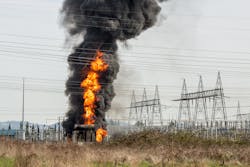Transitions and Transformers: Reducing Fire-Risks in Urban Areas
According to the UN, nearly two-thirds of the global population is set to live in cities by 2050. Coupled with environmental concerns that are pushing trends such as digitalization and electric vehicle uptake, energy infrastructure operators are faced with a double-sided coin. On one side is smarter, more efficient infrastructure, and on the other is higher loads and increased pressure on existing power infrastructure.
As urban intensity increases and users demand more from the grid, it’s no surprise that the MIDEL Transformer Risk Report found that more than 80% of professionals surveyed are concerned about transformer failure. Safety will always be a top priority, so what more can we do to protect highly-populated urban environments from the risk of fires at substations?
Dehli, India’s most populous city, which has an estimated population growth trend of 67.6% to 2035 is a case in point. Transformers are being put to the test by an influx of people and power companies must continue to operate safely under these testing conditions.
For example, CESC Limited, India’s oldest utility based in the Kolkata region of India, serves about 3 million consumers including domestic, industrial and commercial users. CESC operates a wide range of assets in power generation and distribution including more than 8,000 distribution transformers. The majority of these assets are rated between 315 and 500 kVA. In previous decades, CESC needed to install dry-type transformers in densely populated areas to mitigate the risk of fire. However, dry-types are much more expensive than oil-based transformers and no longer represent the most cost-effective solution for managing public safety in built-up areas.
Instead, CESC has opted to trial a highly fire-resistant fluid in some of their transformers: esters. With a fire point of 316° C in comparison to mineral oil’s 170° C, esters provide a greater level of fire safety to protect against the trend of ‘popping’ (exploding transformers), which can cause catastrophic consequences in such a highly-populated environment.
“At CESC, we are working towards the future of India’s energy infrastructure – so using a synthetic ester fluid such as MIDEL 7131 is much more than just selecting a transformer coolant,” says Mithun Roy, assistant manager at CESC Ltd. “MIDEL’s fire safety and biodegradability properties actively facilitate our mission to protect people, the environment and the transformer assets themselves.”
Trial locations include a manufacturing workshop near a school and a plastics factory in a densely-populated area.
Many companies are in a similar boat to CESC with the older parts of their transformer fleet currently filled with mineral oil. However, the switch to esters is an easy one for many. Through the process of retrofilling, the transition to esters doesn’t have to be an instant wholesale change to a transformer fleet – utilities can prioritize the most at-risk assets whilst keeping the rest of their transformers running. In a sector where professionals value the impact of transformer failure on business continuity only behind safety and revenue, the avoidance of downtime due to retrofilling can’t be understated.
In short, there’s no doubt that the energy transition is delivering numerous benefits and with esters being fully biodegradable, there’s no reason why companies can’t enjoy a boost to their sustainability and safety while also looking after their bottom line.
